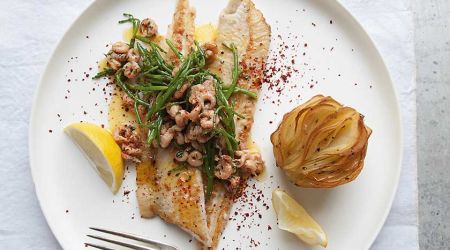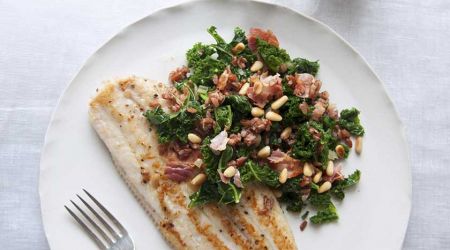Dover Sole
Simplicity is the key to enjoying one of the sea’s most prestigious inhabitants, says Clarissa Hyman
Some years ago, there was serious debate in European circles over the term ‘Dover sole’. It’s ours, claimed the British. ‘How can it be?’ argued the French and others. Fish swim. Fish don’t understand borders and territorial waters. Fish don’t have a nationality. In the end, sanity prevailed (or insanity, depending on your point of view) and nothing changed.
Although the fish is caught in the Mediterranean and all the way up to Norway, it originally gained its name from the fact that Dover was once the best and most reliable source of supply to the London market. At its height in the 1800s, a stagecoach service delivered freshly caught specimens several times
every day.
Whatever its passport says, the Dover sole is by far the finest and most aristocratic of the flatfish family, which ranges from the humble dab up to the halibut. It’s certainly one of the most expensive and a whole sole, grilled on the bone and drizzled with fresh lemon, is arguably as good as it gets.
Should you find such a treasure, don’t be fooled by the apparent simplicity of cooking it. The lovely Solea solea requires attention to detail: not just prime fish but good butter, a little sea salt and enough care to avoid overcooking. A Hollandaise sauce, beurre blanc or pat of anchovy butter is an optional extra.
For cookery writer Elizabeth David, all a sole meunière required was ‘quantities of hissing and foaming butter’ and she was quite adamant about no garnish of any kind.
Dover sole is not hard to fillet as the flesh is yielding but firm and the bone structure is easy to negotiate. However, it’s always entertaining to watch a waiter theatrically debone one at the table.
Most of the recipes in the traditional English repertoire are for sole fillets, and in country houses across the land they were fried in breadcrumbs, either as whole fillets or cut into goujons. As described in Arabella Boxer’s Book of English Food, they were ‘garnished with fried parsley or served with a contrasting sauce, usually cold, sometimes even semi-frozen, like a small sorbet’. She also recalls a between-the-wars dish now forgotten: a souchet of small sole that combined fish and soup. The baby sole were poached then served whole in a soup plate with a delicately flavoured fish consommé spooned over them.
The fillets were prepared in scores of ways, most of which tended to involve rather dated rich sauces. Sole á la Normande is famously elaborate with cream, wine, shallots and shellfish but its excess is the exception that breaks the rule and stands the test of time. Sole Véronique is another, although there are those who think that putting grapes in a sauce is, quite simply, perverse.
The juicy flavour and tightly packed texture of Dover sole need time to develop after rigor mortis sets in: three days from the time of catch is thought best (remember, after packing and transportation, fish can be six or seven days old before they arrive in supermarkets).
If you attempt to cook a very fresh, stiff specimen it will be tough, tasteless and probably curl up and split across the fillet during cooking. A criminal waste of money.
Sole and other flatfish such as plaice have a curious anatomical arrangement. They are dextral fish, which means both of their eyes are located on the right side of the head. The reason for this is that they are adapted to lurking on the seabed at night, half-buried in the sand, ready to prey on any small crustaceans or fish that may swim by. They are almost invisible because of their dark skin and can sink into the sand with the speed of a nuclear sub.
In The Natural History of British Fishes, Victorian writer Frank Buckland, referring to all flatfish, described an incident he witnessed off the coast when a net full of plaice tipped over and the fish tried to escape: ‘A fisherman cried: “Look out, they’ll sand!” a capital expression for I found that the fish sunk into the sand with such rapidity that the operation must be seen to be believed. The plaice lifts up its head and the upper third of its body and then brings it down on the sand three or four times with sharp, quick raps: a small cavity is thus made in the soft, wet sand, which at once fills with water; the fish then works its fins on each side of its body with such a rapid motion that they seem almost to vibrate. These combined efforts enable the fish to conceal itself almost quicker than the eye can follow, and nothing can be seen but its eye, which is of a lovely emerald colour.’
Dover sole are at their best just before spawning in the spring, when they are fat and exquisitely tasty with a fine amount of delicious roe. They come inshore to spawn, which makes them vulnerable to beam trawling, a damaging practice that catches virtually everything in its path and extensively damages the seabed.
The Marine Conservancy Society in its invaluable Good Fish Guide goodfishguide.org advises that the best environmental choices for Dover sole are those caught in the western English Channel and North Sea, especially by the Hastings fleet and the Cooperative Fishery Organisation, both of which are certified sustainable fisheries.
After all, if we are proud to claim the Dover sole as our own, we should make sure that it retains its reputation as the Rolls-Royce of the fish world.
Vital statistics :
Season: January to March (avoid spawning season from April to June)
Farmed: no
Minimum size: 28cm
Omega-3 count: low
Fishing method: fixed trammel nets and baited long lines
Catch range: all around the British coast, from Norway in the North Atlantic and down
as far as Senegal

Recipes
Get Premium access to all the latest content online
Subscribe and view full print editions online... Subscribe




